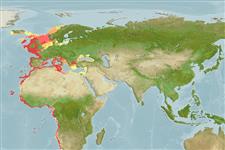Classification / Names
Common names from other countries
Main reference
Size / Weight / Age
Max length : 105 cm TL male/unsexed; (Ref. 53748); 139.0 cm TL (female); common length : 85.0 cm TL male/unsexed; (Ref. 9987); max. published weight: 18.0 kg (Ref. 35388); max. reported age: 15 years (Ref. 41305)
Length at first maturity
Lm 76.6, range 47 - 87.5 cm
Environment
Marine; demersal; depth range 10 - 577 m (Ref. 56504)
Climate / Range
Subtropical, preferred 17°C (Ref. 107945); 70°N - 29°S, 25°W - 42°E
Distribution
Eastern Atlantic: Iceland, Norway, North Sea and the western Baltic southward to Morocco and Namibia, including the Mediterranean and the Black Sea. Although reported from southern Africa, its status in the area is uncertain (Ref. 5578).
Countries | FAO areas | Ecosystems | Occurrences | Introductions
Short description
Dorsal
spines
(total): 0;
Anal
spines: 0;
Anal
soft rays: 0. Sub-rhomboid in shape with pointed wing-tips; disc-width 1,25 to 1,36 times in its length, its length 1,70 to 1,83 times in total length. Short rostrum, rounded at his extremity; pectoral fins with clear angles on lateral side; triangular pelvic fins (Ref. 39246). Dorsally prickly; large females also prickly throughout their ventral surface; juveniles and large males prickly along the margins of their discs and the underside of their snout. 30-50 thorns form a median row from the nape to the first dorsal fin; additional large 'buckler' thorns with swollen bases scattered on upper surface of disc in adults (Ref. 3167). Coloration is highly variable, with the dorsal surface having all shades of brown with dark and light spots and blotches; ventral surface white (Ref. 3167, 58137).
IUCN Red List Status (Ref. 115185)
Threat to humans
Harmless
Human uses
Fisheries: commercial; gamefish: yes
Tools
Special reports
Download XML
Internet sources
Estimates of some properties based on models
Phylogenetic diversity index
PD50 = 0.5000 many relatives (e.g. carps) 0.5 - 2.0 few relatives (e.g. lungfishes)
Trophic Level
3.8 ±0.2 se; Based on diet studies.
Resilience
Low, minimum population doubling time 4.5 - 14 years (K=0.09-0.14; tm=10; tmax=23; Fec=150)
Vulnerability
High to very high vulnerability (72 of 100)
Price category
